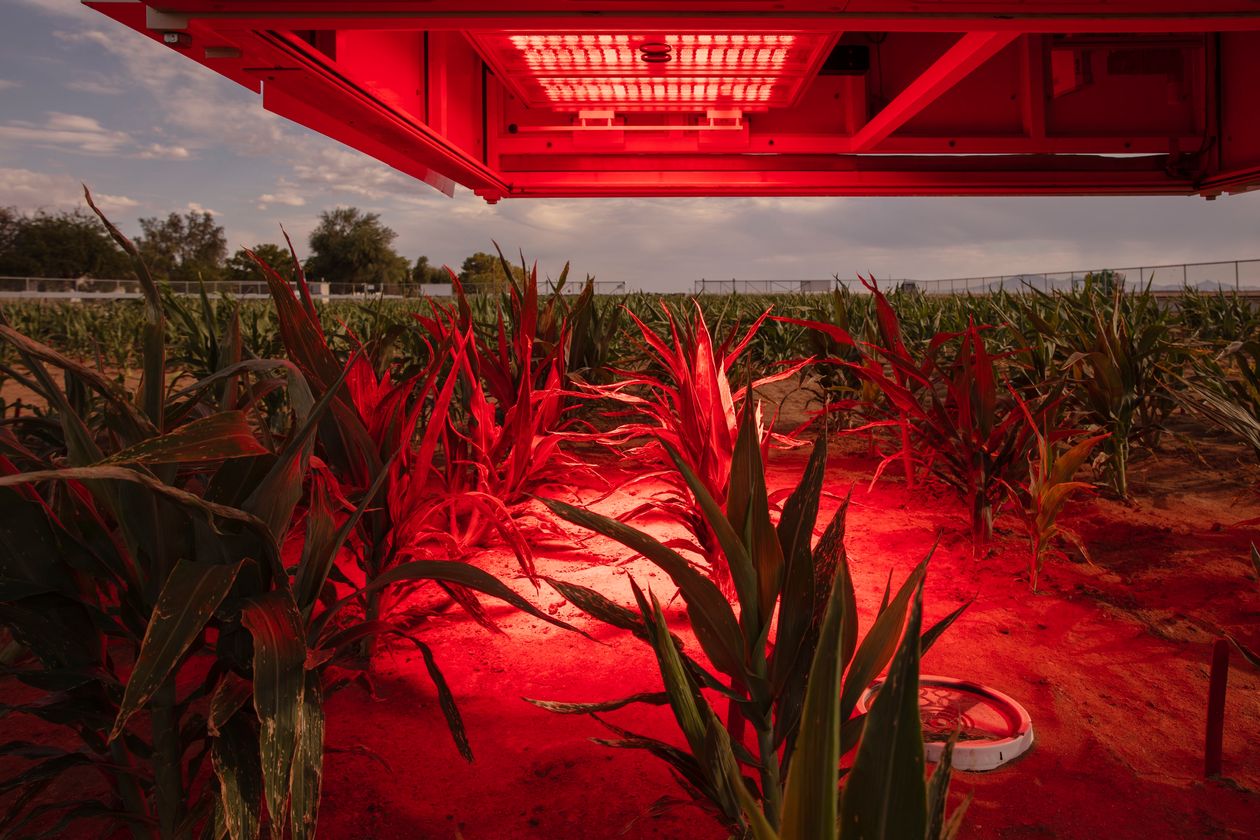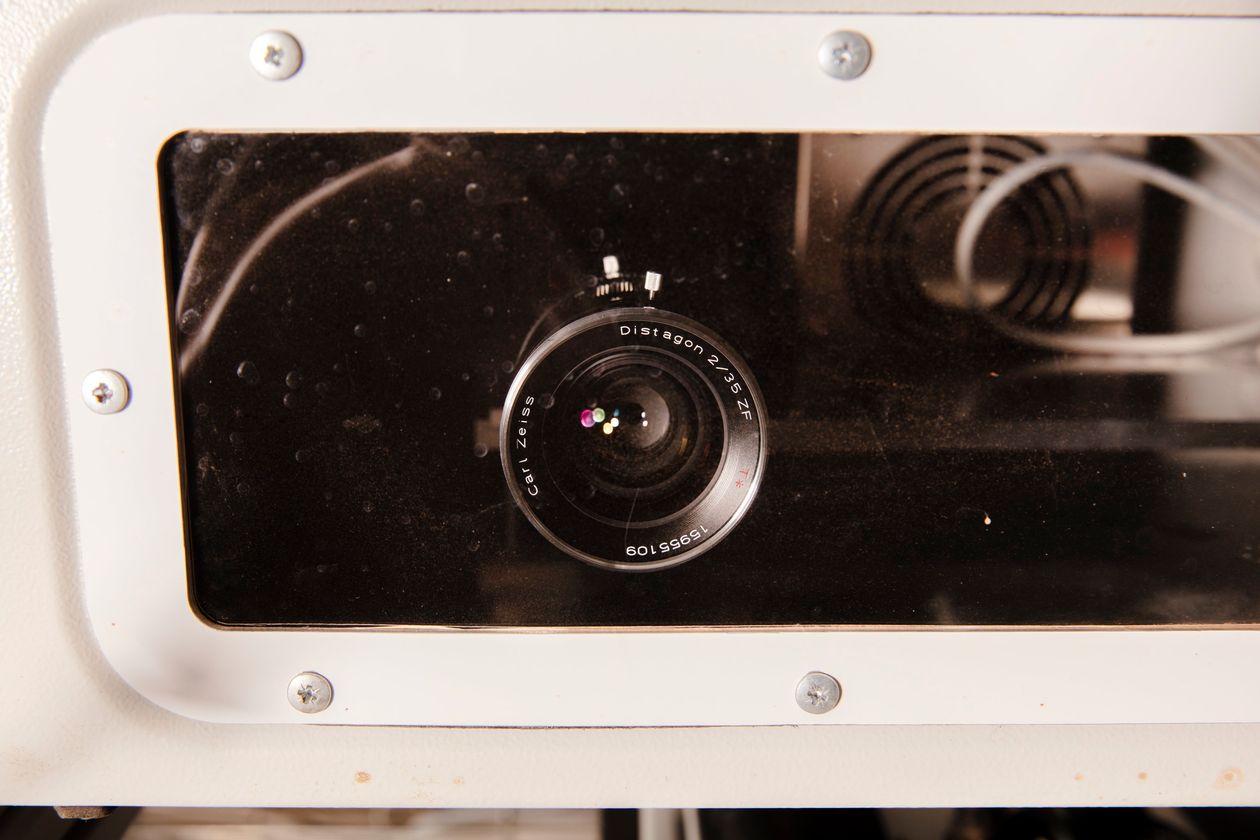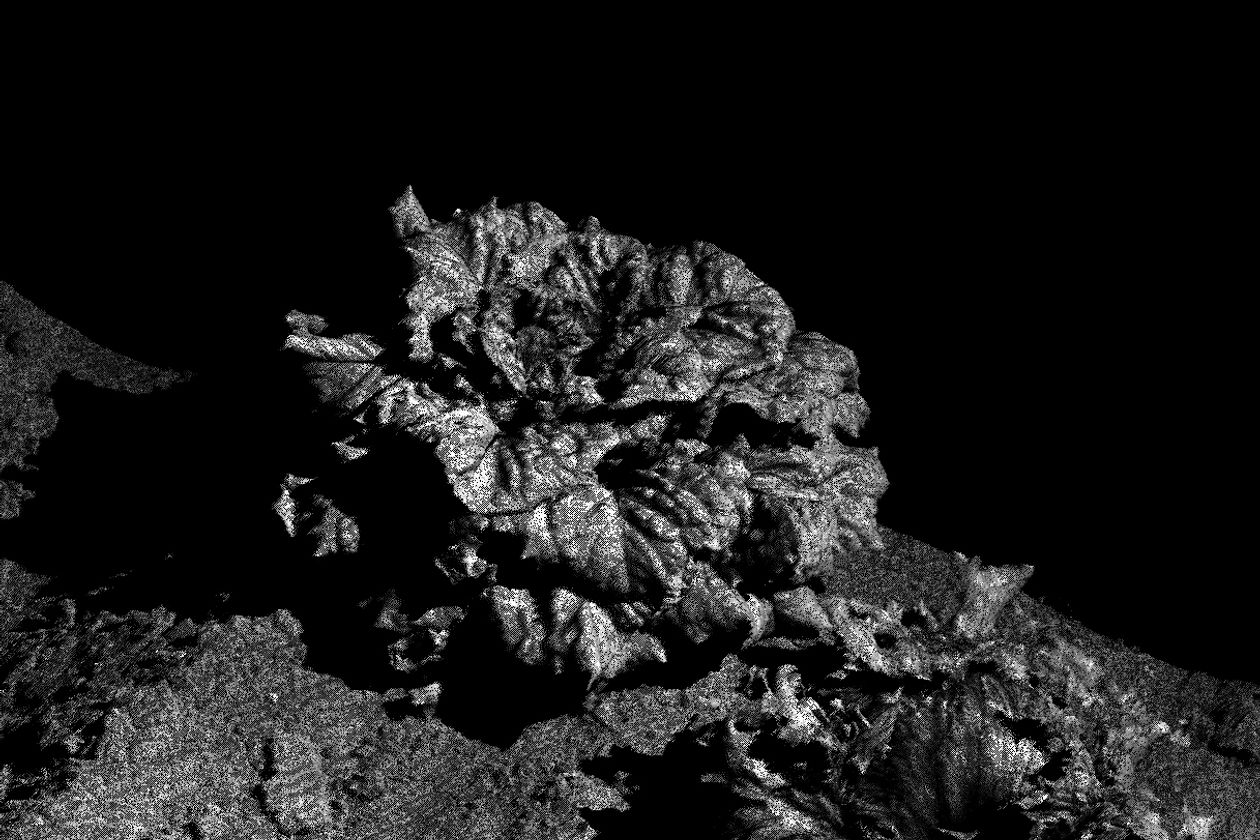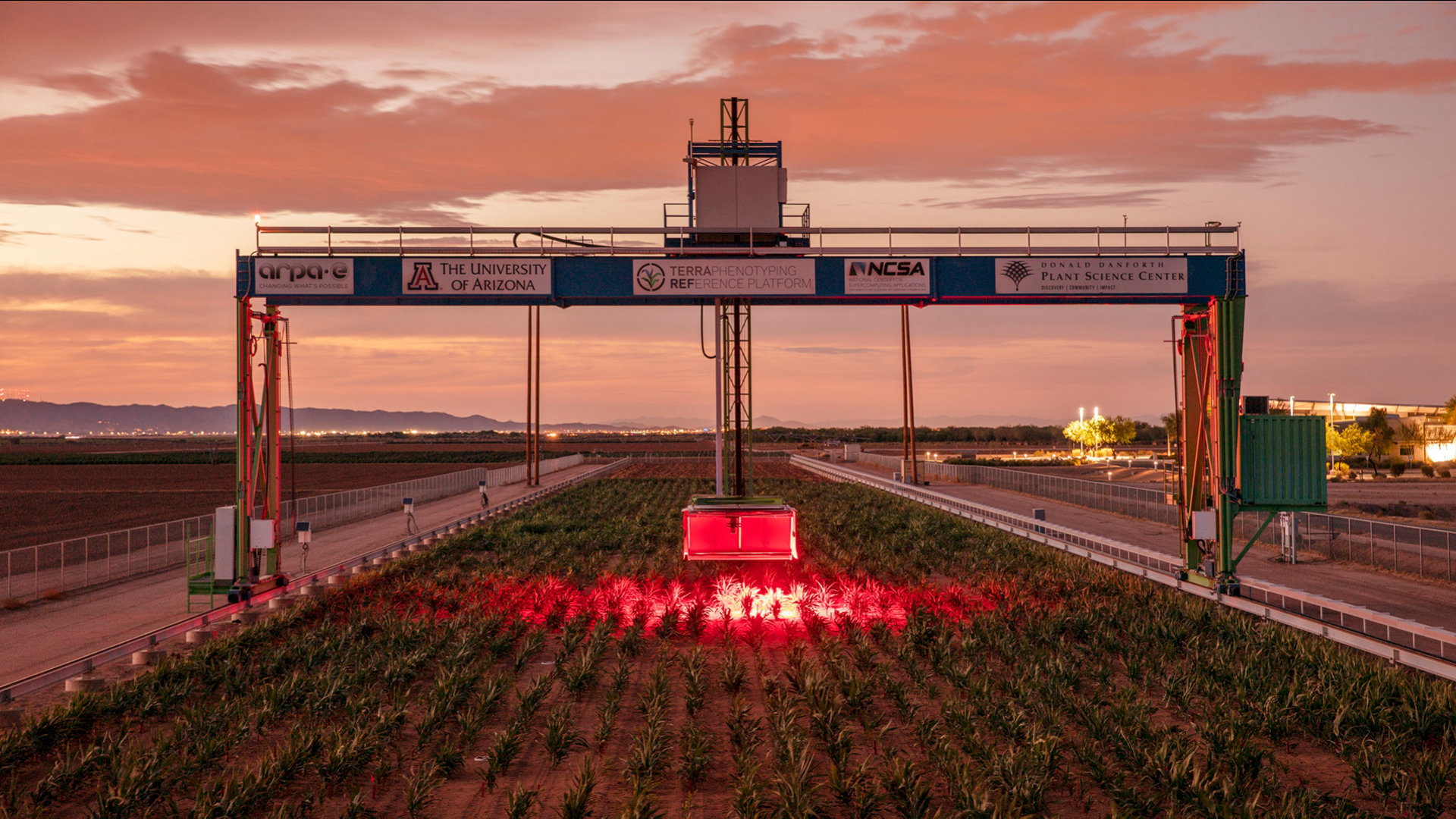What makes a plant thrive in the heat? In the Arizona desert, the ‘Field Scanalyzer’ is collecting data to learn the answer—and hopefully improve farming for biofuels and food.
Arizona has what researchers call ‘the climate of tomorrow, today.’ Scientists are using a 30-ton robotic field scanner in the state to study plant genetics and hopefully develop stress-resilient crops.
On a green swatch in the Arizona desert, a 30-ton robot is scrutinizing plants that could help feed impoverished countries and fuel American cars.
The 70-foot-tall colossus, called a “Field Scanalyzer,” is the world’s biggest agricultural robot, the project’s researchers say. Resembling an oversize scaffold with a box perched in its middle, it lumbers daily over 2 acres of crops including sorghum, lettuce and wheat, its cluster of electronic eyes assessing their temperature, shape and hue, the angle of each leaf.
THE QUIET GROWTH OF RACE-DETECTION SOFTWARE SPARKS CONCERNS OVER BIAS
The Scanalyzer beams this data—up to 10 terabytes a day, roughly equivalent to about 2.6 million copies of Tolstoy’s “War and Peace”—to computers in Illinois and Missouri. Analyzing the range and depth of data generated is possible only with machine-learning algorithms, according to data scientists at George Washington University and St. Louis University, where researchers are teaching the computers to identify connections between specific genes and plant traits the Scanalyzer observes.

PHOTO: JESSE RIESER FOR THE WALL STREET JOURNAL
Deep learning, a form of AI that uses conclusions from data to further refine a system, can also help pinpoint how some varieties of a plant may subtly differ from one another in ways that plant scientists may not anticipate, researchers say.
The effort—part of a five-year, roughly $26 million project funded by the U.S. Department of Energy and the Bill and Melinda Gates Foundation—is aimed at helping plant breeders identify characteristics and genetic markers pointing to the most efficient and resilient crop varieties. Researchers are seeking to develop crops that can produce biofuels, reducing reliance on fossil fuels. It could also help identify food crops that can thrive in drier, hotter conditions as climates change.
“There are opportunities here to figure out the things that are most important, things we didn’t know before, or different combinations of features,” says Abby Stylianou, assistant professor of computer science at St. Louis University, who is developing machine-learning models for the project. “Maybe it’s wide and hot leaves that correspond to some particular output you care about.”
The data sets are also being used to test-drive AI tools that could be applied to research into human aging or disease progression, says Robert Pless, chair of computer science at George Washington University, who has worked on the Scanalyzer’s data from the project’s beginning.
Some agriculture companies already are incorporating AI into their decadeslong efforts to produce better-performing seeds for farmers: Bayer AG , the world’s largest crop seed supplier, says it has developed a self-teaching algorithm to predict crop seeds’ performance, helping the company expand its corn seed development pipeline by four times versus 2012 levels, and soybeans by six times, while saving a year of research time.

PHOTO: JESSE RIESER FOR THE WALL STREET JOURNAL
The Scanalyzer got its start as part of a government-funded program called Transportation Energy Resources from Renewable Agriculture, which aims to help solve long-term energy challenges, researchers say.
The system’s two massive legs straddle a 92-foot-wide, 1,200-foot-long strip of irrigated field, using wheels mounted on tracks to traverse the rows at a few centimeters per second. Suspended between the two legs is the box crammed with lenses, sensors, and other scanning equipment that track each plant’s growth rate, height, development, and hardiness, capturing images at finer detail than humans can detect with the naked eye. The sensor array can count lesions on leaves caused by disease, and how a leaf’s angle relative to the stalk may affect photosynthesis.

PHOTO: JESSE RIESER FOR THE WALL STREET JOURNAL
After constructing the robot in 2016, researchers spent the first few years testing varieties of sorghum, a grain that can thrive in hot and dry conditions, for Energy Department-funded research into new crops for alternative fuel sources. Corn, the primary crop used in the U.S. ethanol industry, typically requires more water and fertilizer.
In 2017, the Gates Foundation pledged more than $1 million to train the Scanalyzer’s eye on food crops, such as grains suited to developing regions such as sub-Saharan Africa. Researchers have recently tested wheat and lettuce varieties.
Climate change is among the biggest challenges facing global agriculture, with shifts in temperature and rainfall pushing some crops into new regions, and reducing yields and quality elsewhere. “In Arizona, we have the climate of the future now,” says Duke Pauli, assistant professor of plant sciences at the University of Arizona, who helps manage day-to-day Scanalyzer activities.

PHOTO: THE SCHOOL OF PLANT SCIENCES|, UNIVERSITY OF ARIZONA
While Arizona’s sometimes harsh environment is suited to testing plants’ resilience, it can pose challenges for the robot itself. Dust has occasionally disrupted its electronics, and birds have built nests that obscured its sensors. One close call came in 2019, when a malfunction left the Scanalyzer immobilized as a thunderstorm rolled in. Workers used two pickup trucks to tow the robot between an array of poles that protect it from lightning strikes.
“You’re asking for trouble when you have a massive hunk of steel out in the desert,” says Todd Mockler, principal investigator at the Donald Danforth Plant Science Center in suburban St. Louis, which is helping interpret the Scanalyzer’s findings.
Some see bigger-picture challenges. Jeffrey White, a retired U.S. Department of Agriculture plant physiologist who worked on the project, says low-cost drones increasingly are able to do many of the same scans. For now, though, researchers say drones aren’t able to match the clarity and detail of the images generated by the Scanalyzer system.
Biofuel research elsewhere has hit hurdles, particularly efforts that range beyond the most common corn-based ethanol approaches. DuPont Co. in 2018 pulled out of a long-running effort to produce ethanol from corn stalks and leaves, selling its Iowa production plant after profit proved elusive. Poet LLC, another major ethanol producer, in late 2019 paused a similar joint venture with Royal DSM, and laid off some workers.
Mr. Mockler says the long term research that can be done with the Scanalyzer will help overcome biofuel development challenges.
“Nobody’s ever built one of these, and nobody knows how it’s going to work,” says Mr. Pauli. “Every day’s a challenge.”
WSJ / Balkantimes.press
Napomena o autorskim pravima: Dozvoljeno preuzimanje sadržaja isključivo uz navođenje linka prema stranici našeg portala sa koje je sadržaj preuzet. Stavovi izraženi u ovom tekstu autorovi su i ne odražavaju nužno uredničku politiku The Balkantimes Press.
Copyright Notice: It is allowed to download the content only by providing a link to the page of our portal from which the content was downloaded. The views expressed in this text are those of the authors and do not necessarily reflect the editorial policies of The Balkantimes Press.

